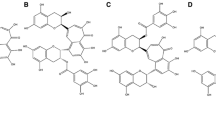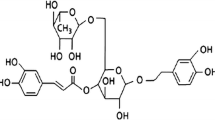Abstract
Oxidative stress plays an important role in many neurodegenerative disorders. In this study, the effect of baicalein, a natural flavonoid isolated from the root of Scutellaria baicalensis G., on hydrogen peroxide (H2O2)-induced cytotoxicity in PC12 cells were investigated. Exposure of PC12 cells to 0.15 mM H2O2 for 20 min induced a significant decrease in cell viability accompanied by increased oxidative stress, mitochondrial dysfunction, downregulation of Bcl-2, upregulation of Bax, and cell apoptosis. Pretreatment of PC12 cells with baicalein inhibited H2O2-induced cell viability loss, intracellular reactive oxygen species generation, and lipid peroxidation in a dose-dependent manner. Meanwhile, baicalein potentially inhibited H2O2-induced cell apoptosis characterized with the DNA fragment. And the mitochondrial pathway involving the mitochondrial dysfunction associated with cell apoptosis including membrane potential loss, the release of cytochrome c, the downregulation of Bcl-2, upregulation of Bax induced by H2O2 were also abrogated in the presence of baicalein. Taken together, these results suggest that baicalein can block H2O2-induced apoptosis by prevention of oxidative stress as well as regulation of Bcl-2 family members and suppression of mitochondria dysfunction, which might be beneficial for the treatment of oxidative stress in aging and age-associated neurodegenerative diseases.





Similar content being viewed by others
Abbreviations
- PC12:
-
Pheochromocytoma cells
- DMSO:
-
Dimethylsulfoxide
- DCF-DA:
-
Dichlorofluorescin diacetate
- MDA:
-
Malonyl dialdehyde
- MTT:
-
3(4,5-Dimethylthiazol-2yl)2,5-diphenyl-2H-tetrazolium bromide
- PBS:
-
Phosphate-buffered saline
- ROS:
-
Reactive oxygen species
- LPO:
-
Lipid peroxidation
- RFU:
-
Relative fluorescence unit
References
Budihardjo I, Olive H, Lutter M, Luo X, Wang X (1999) Biochemical pathways of caspase activation during apoptosis. Annu Rev Cell dev Biol 15:269–290
Butterfield DA, Koppal T, Howard B et al (1998) Structural and functional changes in proteins induced by free radical-mediated oxidative stress and protective action of the antioxidants N-tert-butyl-alpha-phenylnitrone and vitamin E. Ann N Y Acad Sci 854:448–462
Chen S, Ruan Q, Bedner E, Deptala A, Wang X, Hsieh TC, Traganos F, Darzynkiewicz Z (2001) Effects of the flavonoid baicalin and its metabolite baicalein on androgen receptor expression, cell cycle progression and apoptosis of prostate cancer cell lines. Cell Prolif 34(5):293–304
Chong ZZ, Li F, Maiese K (2005) Oxidative stress in the brain: novel cellular targets that govern survival during neurodegenerative disease. Prog Neurobiol 75:207–246
Gao Z, Huang K, Yang X, Xu H (1999) Free radical scavenging and antioxidant activities of flavonoids extracted from the radix of Scutellaria baicalensis Georgi. Biochim Biophys Acta 1472:643–650
Gao Z, Huang K, Xu H (2001) Protective effects of flavonoids in the root of Scutellaria baicalensis Georgi against hydrogen peroxide-induced oxidative stress in HS-SY5Y cells. Pharmacol Res 43:173–178
Gilgun-Sherki Y, Rosenbaum Z, Melamed E, Offen D (2002) Antioxidant therapy in acute central nervous system injury: current state. Pharmacol Rev 54:271–284
Giorgio M, Trinei M, Migliaccio E, Pelicci PG (2007) Hydrogen peroxide: a metabolic by-product or a common mediator of ageing signals? Nat. Rev. Mol. Cell Biol 8:722–728
Gutteridge JM, Halliwell B (2000) Free radicals and antioxidants in the year 2000. A historical look to the future. Ann N Y Acad Sci 899:136–147
Halliwell B, Aruoma OI et al (1991) DNA damage by oxygen-derived species. Its mechanism and measurement in mammalian systems. FEBS Lett 281:9–19
Hetz C, Vitte PA, Bombrun A, Rostovtseva TK et al (2005) Bax channel inhibitors prevent mitochondrion-mediated apoptosis and protect neurons in a model of global brain ischemia. J Biol Chem 280(52):42960–42970
Hodnick WF, Kung FS, Roettger WJ, Bohmont CW, Pardini RS (1986) Inhibition of mitochondrial respiration and production of toxic oxygen radicals by flavonoids. A structure–activity study. Biochem Pharmacol 35:2345–2357
Hodnick WF, Milosavljevic EB, Nelson JH, Pardini RS (1998) Electrochemistry of flavonoids: relationships between redox potentials, inhibition of mitochondrial respiration, and production of oxygen radicals by flavonoids. Biochem Pharmacol 37:2607–2611
Ischiropoulos H, Beckman JS (2003) Oxidative stress and nitration in neurodegeneration: cause, effect, or association? J Clin Invest 111:163–169
Jonas EA, Hardwick JM, Kaczmarek LK (2005) Actions of BAX on mitochondrial channel activity and on synaptic transmission. Antioxid Redox Signal 7(9–10):1092–1100
Kirkland RA, Franklin JL (2003) Bax, reactive oxygen, and cytochrome c release in neuronal apoptosis. Antioxid Redox Signal 5(5):589–596
Le Bel C, Ischiropoulos H, Bondy SC (1992) Evaluation of the probe 2′, 7′-dichlorofluorescin as an indicator of reactive oxygen species formation and oxidative stress. Chem Res Toxicol 5:227–231
Lebeau A, Esclaire F, Rostène W, Pélaprat D (2001) Baicalein protects cortical neurons from beta-amyloid (25–35) induced toxicity. NeuroReport 12(10):2199–2202
Lee YS, Kwon EJ, Jin DQ, Park SH, Kang YS, Huh K, Kim JA (2002) Redox status-dependent regulation of cyclooxygenases mediates the capsaicin-induced apoptosis in human neuroblastoma cells. J. Environ. Pathol. Toxicol. 21(2):113–120
Lin CC, Shieh DE (1996) The anti-inflammatory activity of Scutellaria rivularis extracts and its active components, baicalin, baicalein and wogonin. Am J Chin Med 24(1):31–36
Liu X, Zhu XZ (1999) Roles of P53, c-Myc, Bcl-2, Bax and caspase in glutamate-induced neuronal apoptosis and the possible neuroprotective mechanism of basic fibroblast growth factor. Mol Brain Res 70:201–206
Lindsten T, Zong WX, Thompson CB (2005) Defining the role of the Bcl-2 family of proteins in the nervous system. Neuroscientist 11(1):10–15
Maheshwari A, Misro MM, Aggarwal A, Sharma RK, Nandan D (2009) Pathways involved in testicular germ cell apoptosis induced by H2O2 in vitro. FEBS J 276:870–881
Martindale JL, Holbrook NJ (2002) Cellular response to oxidative stress: signaling for suicide and survival. J Cell Physiol 192:1–15
Mihara M, Uchiama M (1978) Determination of malonaldheyde precursor in tissues by thiobarbituric acid test. Anal Biochem 86:271–278
Miura YH, Tomita I, Watanabe T, Hirayama T, Fukui S (1998) Active oxygens generation by flavonoids. Biol Pharm Bull 21:93–96
Naoi M, Maruyama W, Shamoto-Nagai M, Yi H, Akao Y, Tanaka M (2005) Oxidative stress in mitochondria: decision to survival and death of neurons in neurodegenerative disorders. Mol Neurobiol 31(1–3):81–93
Okouchi M, Ekshyyan O, Maracine M, Aw TY (2007) Neuronal apoptosis in neurodegeneration. Antioxid Redox Signal 9:1059–1096
Perry EK, Pickering AT, Wang WW, Houghton PJ, Perry NS (1999) Medicinal plants and Alzheimer’s disease: from ethnobotany to phytotherapy. J Pharm Pharmacol 51(5):527–534
Petit PX, Susin SA, Zamzami N, Mignotte B, Kroemer G (1996) Mitochondria and programmed cell death: back to the future. FEBS Lett 396(1):7–13
Polster BM, Fiskum G (2004) Mitochondrial mechanisms of neural cell apoptosis. J Neurochem 90(6):1281–1289
Rao AV, Balachandran B (2002) Role of oxidative stress and antioxidants in neurodegenerative diseases. Nutr. Neurosci. 5:291–309
Reed JC (1997) Bcl-2 family proteins: regulators of apoptosis and chemoresistance in hematologic malignancies. Semin Hematol 34:9–19
Rhee SG (1999) Redox signaling: hydrogen peroxide as intracellular messenger. Exp. Mol. Med. 31:53–59
Ryter SW, Kim HP, Hoetzel A, Park JW, Nakahira K, Wang X, Choi AM (2007) Mechanisms of cell death in oxidative stress. Antioxid Redox Signal 9(1):49–89
Shao ZH, Vanden Hoek TL, Qin Y, Becker LB, Schumacker PT, Li CQ et al (2002) Baicalein attenuates oxidant stress in cardiomyocytes. Am J Physiol Heart Circ Physiol 282:H999–H1006
Shieh DE, Liu LT, Lin CC (2000) Antioxidant and free radical scavenging effects of baicalein, baicalin and wogonin. Anticancer Res 20(5A):2861–2865
Soane L, Fiskum G (2005) Inhibition of mitochondrial neural cell death pathways by protein transduction of Bcl-2 family proteins. J Bioenerg Biomembr 37(3):179–190
Spencer JP, Jenner A, Aruoma OI et al (1994) Intense oxidative DNA damage promoted by L-dopa and its metabolites. Implications for neurodegenerative disease. FEBS Lett 353(3):246–250
Sun XM, Bratton SB, Butterworth M, MacFarlane M, Cohen GM (2002) Bcl-2 and Bcl-xL inhibit CD95-mediated apoptosis by preventing mitochondrial release of Smac/DIABLO and subsequent inactivation of X-linked inhibitor-of-apoptosis protein. J Biol Chem 277:11345–11351
Telford WG, King LE, Fraker PJ (1991) Evaluation of glucocorticoid-induced DNA fragmentation in mouse thymocytes by flow cytometry. Cell Prolif 24(5):447–459
Thannickal VJ, Fanburg BL (2000) Reactive oxygen species in cell signaling. Am J Physiol Lung Cell Mol Physiol 279:L1005–L1028
Waris G, Ahsan H (2006) Reactive oxygen species: role in the development of cancer and various chronic conditions. J Carcinog 5:14
Wu JA, Attele AS, Zhang L, Yuan CS (2001) Anti-HIV activity of medicinal herbs: usage and potential development. Am J Chin Med 29(1):69–81
Youdim KA, Spencer JP, Schroeter H, Rice-Evans C (2002) Dietary flavonoids as potential neuroprotectants. Biol Chem 383:503–519
Zhang Y, Zhao B (2003) Green tea polyphenols enhance sodium nitroprusside- induced neurotoxicity in human neuroblastoma SH-SY5Y cells. J Neurochem 86(5):1189–1200
Zhang Y, Dawson VL, Dawson TM (2000a) Oxidative stress and genetics in the pathogenesis of Parkinson’s disease. Neurobiol Dis 7:240–250
Zhang YW, Morita I, Zhang L, Shao G, Yao XS, Murota S (2000b) Screening of anti-hypoxia/reoxygenation agents by an in vitro model. Part 2: inhibition of tyrosine kinase activation prevented hypoxia/reoxygenation-induced injury in endothelial gap junctional intercellular communication. Planta Med 66(2):119–23
Zhao B (2009) Natural antioxidants protect neurons in Alzheimer’s disease and Parkinson’s disease. Neurochem Res 34(4):630–638
Acknowledgments
We thank Dr. Lu Ling for her input and technical assistance. We also acknowledge the generous support of the Natural Science Foundation of Shandong Province, China (Grant No. Q2008C04).
Author information
Authors and Affiliations
Corresponding author
Additional information
Shehua Zhang and Junli Ye contributed equally to this work.
Rights and permissions
About this article
Cite this article
Zhang, S., Ye, J. & Dong, G. Neuroprotective Effect of Baicalein on Hydrogen Peroxide-Mediated Oxidative Stress and Mitochondrial Dysfunction in PC12 Cells. J Mol Neurosci 40, 311–320 (2010). https://doi.org/10.1007/s12031-009-9285-5
Received:
Accepted:
Published:
Issue Date:
DOI: https://doi.org/10.1007/s12031-009-9285-5




